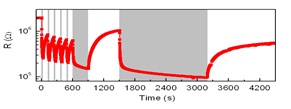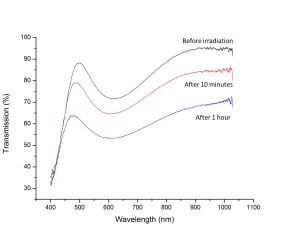Photochromics
Purpose: On average 30-40% of the energy consumption in the developed world is in the building sector. Smart energy saving windows are envisaged to play an important role in bringing this number down. At present, the complexity and cost of this technology is prohibitive. Photochromic smart windows, due to their simplicity, would present a breakthrough. At present, the slow speed and UV dependence prohibits such an application.


Effect of illumination on the light absorption (left) and resistivity (right) on as-deposited YOyHx film.
Aim: We aim for a breakthrough in terms of photochromic contrast and speed of transition. Recently a very special photochromic effect was discovered in YOyHx (IFE, TU Delft). This ternary oxy-hydride is unique, since it allows for a photochromic effect induced by light in the visible part of the optical spectrum. Moreover, the photochromic darkening is colourless, resulting in a uniform darkening of the visible transparency. The physics of this effect has not yet been elucidated.

Effect of illumination on the optical transmission in a 200 nm YOyHx thin film, using a white halogen light source.
Approach: We will identify the fundamental nature of the light-induced optical effects in Yttrium and related ternary oxyhydrides, in relation to the microstructure and chemical composition. On the basis of the physical understanding obtained, our second goal is to tailor the photochromic properties towards the application as an energy saving window. Changes in the transmission of electromagnetic radiation (IR and visible range) allow for the design of smart windows, which control the optical transmission and act as adjustable thermal barriers.
Papers:
A new thin film photochromic material: Oxygen-containing yttrium hydride
Collaboration:
- Andreas Borgschulte (EMPA, Switzerland)
- Smagul Karazhanov (IFE, Norway)
- Helmholtz Zentrum Dresden (Germany)